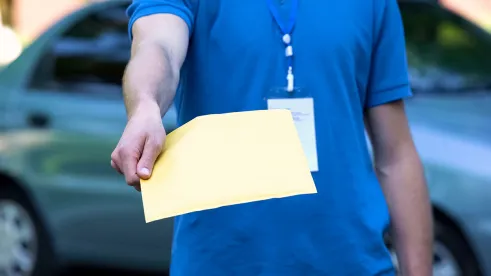Introduction
Unless Congress intervenes, the first-ever substantive amendment to Federal Rule of Civil Procedure 30(b)(6) will take effect on 1 December 2020.[1] Governing oral depositions of party and nonparty organizations, Rule 30(b)(6)’s original purpose, when it was introduced in 1970, was to ensure a fair and even playing field so organizations would not receive special advantages during the discovery process.[2] To achieve this purpose, the Rule, in its current form, has two requirements: (1) from the party seeking to take the deposition, a notice containing a description with “reasonable particularity” of the matters for examination; and (2) from the organization being deposed, the designation of one or more persons to testify on the organization’s behalf as to those matters.[3]
For years, problematic practices by lawyers on both sides, such as poorly drafted notices and inadequately prepared witnesses, have created a unique challenge to the Advisory Committee on Civil Rules (“Advisory Committee”). Unable to find adequate solutions, the Advisory Committee finally convened a Rule 30(b)(6) Subcommittee in 2016 to tackle the problem. Two years later, through that Subcommittee’s exhaustive efforts, a proposed amendment (the “Preliminary Proposed Amendment”) was published for public comment.[4]
The Preliminary Proposed Amendment and Concerns
The Preliminary Proposed Amendment, published in August 2018, provided, in pertinent part:
Before or promptly after the notice or subpoena is served, and continuing as necessary, the serving party and the organization must confer in good faith about the number and description of the matters for examination and the identity of each person the organization will designate to testify. A subpoena must advise a nonparty organization of its duty to make this designation and to confer with the serving party.[5]
While plaintiffs’ bars generally supported the Preliminary Proposed Amendment, stating that the proposal struck the right balance,[6] there was considerable push back from organizations.
In a letter to the Advisory Committee dated 5 February 2019, more than 100 companies banded together in opposition, arguing that the conferral mandate, as written, would not only “provoke time-consuming and costly new discovery disputes” as a result of the serving party’s new ability and right to influence the choice of the witness(es),[7] but it would also spawn additional motion practice as a result of vague and undefined terms and phrases like “good faith” and “continuing as necessary.”[8] The primary concerns were that the amendment would permit serving parties to request multiple witnesses[9] or c-suite executives for purposes of harassment,[10] or even devise ways to block unfavorable witnesses.
Equally disconcerting to the signatory companies was the observation that the Preliminary Proposed Amendment “offer[ed] no solutions to the pressing major failings of the current Rule 30(b)(6) deposition process.” Rather than a conferral mandate, the companies submitted that it would have been better for the proposal to address Rule 30(b)(6)’s major gaps, including how to count the number of hours allowed for a deposition with multiple designated witnesses and what should happen in instances where an organization no longer has relevant knowledge due to the passage of time or other reasons.[11]
New Proposed Amendment Ultimately Approved by the Advisory Committee
Taking into consideration all of the comments received during the official comment period, especially those that robustly opposed the requirement to confer about the “number and description of matters for examination” and the “identity of each witness,” the Advisory Committee settled on a more modest version of the amendment (the “New Proposed Amendment’):
Before or promptly after the notice or subpoena is served, the serving party and the organization must confer in good faith about the matters for examination. A subpoena must advise a nonparty organization of its duty to confer with the serving party and to designate each person who will testify.[12]
As the Committee on Rules of Practice and Procedure stated in its Memorandum to the Supreme Court of the United States on 23 October 2019, the scaled-back New Proposed Amendment “codifies a best practice and practitioners across the bar support it.”[13] To “confer in good faith” means just that–nothing in the Rule requires the parties to actually reach any agreement.[14]
Issues the New Proposed Amendment Seeks to Resolve
Primarily, the New Proposed Amendment aims to respond to concerns such as “overlong or ambiguously worded lists of matters for examination and inadequately prepared witnesses.”[15] By resolving these issues, it “facilitates collaborative efforts,” which are important in achieving proportionality goals of the 2015 amendments to Rules 1 and 26(b)(1).[16]
Secondarily, “candid exchanges” with respect to “purposes of the deposition and the organization’s information structure” may clarify matters for examination, which will give organizations specific guidance on designating and preparing witnesses.[17] These discussions, as well as others pertaining to procedural issues like the timing and location of the deposition, seek to minimize disputes down the road.
As the Honorable David G. Campbell, Chairman for the Committee on Rules of Practice and Procedure, commented, getting the parties to talk before the deposition will help resolve some of the most frequent complaints lawyers have about the deposition process (e.g., overly broad topics and inadequately prepared witnesses), as a result of lack of communication.[18]
Timeline and Process for Approval
After the close of the official comment period on 15 February 2019,[19] and considering all feedback received, the Advisory Committee submitted the New Proposed Amendment to the Committee on Rules of Practice and Procedure[20]. The Judicial Conference of the United States approved the New Proposed Amendment on 17 September 2019, and transmitted it to Scott Harris, Clerk of the Supreme Court of the United States, on 23 October 2019.[21] By letter dated 27 April 2020, the Supreme Court submitted the New Proposed Amendment to Nancy Pelosi, Speaker of the House of Representatives, and Michael Pence, Vice President.[22]
Congress, which is the last stop in the review process, now has several months to reject, modify, or defer the New Proposed Amendment.[23] Absent any such action, the New Proposed Amendment will become effective 1 December 2020.
Conclusion
Rule 30(b)(6) depositions are significant to organizations and even the slightest modifications to the rule and process can have a significant impact. For example, counsel for the serving party, in documenting the parties’ meet and confers, may seek to file a motion to compel if an organization’s witness later states that he or she is not prepared for a topic that the parties previously clearly discussed. Counsel for organizations, therefore, should be prepared for strategies like these. Counsel, however, should also be able to use the new required meet-and-confer obligation to their advantage to further understand the specific topics of the deposition testimony, better prepare witnesses, and limit the number of hours witnesses are made available, if more than one witness is required.
NOTES
[1] See generally STEVEN BAICKER-MCKEE, WILLIAM M. JANSSEN, & JOHN B. CORR, FEDERAL CIVIL RULES HANDBOOK, Part. I, at 5 (2019) (citing 28 U.S.C. § 2074 and stating that after transmittal from the Supreme Court to Congress, Congress has a “statutory period of at least 7 months” to act on any proposed amendment. If Congress “does not enact legislation to reject, modify, or defer the rules, they take effect as a matter of law on December 1 . . . .”)
[2] See ADVISORY COMMITTEE ON CIVIL RULES, RULE 30(B)(6) SUBCOMMITTEE REPORT 241 (Apr. 25–26, 2017), http://www.uscourts.gov/sites/default/files/2017-04-civil-agenda_book.pdf (“The Rule 30(b)(6) option was introduced in the 1970 amendment package as a way to deal with "bandying," an avoidance behavior reportedly used by some organizational litigants to make it more difficult for their litigation opponents to identify persons with knowledge and nail down organizational information.”). See also id. at 78, 80 (stating that over time, Rule 30(b)(6) depositions became increasingly used as a way to “set the foundation for other discovery . . . .” and to “start discovery . . . in the least expensive way.”).
[3] See Fed. R. Civ. P. 30(b)(6).
[4] See Memorandum from the Honorable David G. Campbell, Committee on Rules of Practice and Procedure of the Judicial Conference of the United States, to Scott S. Harris, Clerk, Supreme Court of the United States 63 (Oct. 23, 2019) [hereinafter “TRANSMITTAL TO SUPREME COURT”], https://www.uscourts.gov/sites/default/files/2019-10-23_scotus_package_final_for_posting_0.pdf.
[5] COMMITTEE ON RULES OF PRACTICE AND PROCEDURE OF THE JUDICIAL CONFERENCE OF THE UNITED STATES, PRELIMINARY DRAFT OF PROPOSED AMENDMENTS TO THE FEDERAL RULES OF APPELLATE, BANKRUPTCY, AND CIVIL PROCEDURE, AND THE FEDERAL RULES OF EVIDENCE, RULE 30 33–34 (Aug. 2018) [hereinafter “PRELIMINARY DRAFT OF PROPOSED AMENDMENTS”], https://www.uscourts.gov/sites/default/files/2018_proposed_rules_amendments_published_for_public_comment_0.pdf.
[6] JUDICIAL CONFERENCE ADVISORY COMMITTEE ON CIVIL RULES, PUBLIC HEARING ON PROPOSED AMENDMENTS TO THE FEDERAL RULES OF CIVIL PROCEDURE, , Tab 20–Comment of National Employment Lawyers Association dated Dec. 21, 2018 1 (Feb. 8, 2019), https://www.uscourts.gov/sites/default/files/testimony_package_for_2-8-19_hearing_as_of_2-6-2019.pdf (“[W]e believe that the decision to add a formal meet and confer process strikes the right balance. With respect to the requirement of a meet and confer on the number and description of topics, we note that experienced counsel already do this when the need arises. We agree that making it an explicit requirement will ultimately reduce disputes and promote efficiency.”).
[7] Id. Tab 8–Comments of Lawyers for Civil Justice and 138 Companies dated Sept. 12, 2018, Letter Attachment from 138 Companies dated Feb. 5, 2019.
[8] Id.; see also id. Tab 23–Comment of Ford Motor Company dated Jan. 7, 2019 1 (“[B]y including a conferral requirement about witness identity, the proposed rule changes would substantially interfere with an organization’s existing right to identify its own witnesses, thereby giving rise to a whole new category of discovery abuses and disputes”).
[9] See e.g., Fed. R. Civ. P. 30(d). Subsection (d), pertaining to duration, imposes a seven-hour limit on each deposition. Nothing therein prevents a serving party from deposing more than one witness.
[10] See, e.g., Celerity, Inc. v. Ultra Clean Holding, Inc., No. C 05-4374MMC(JL), 2007 WL 205067, at *3 (N.D. Cal. Jan. 25, 2007) (“Virtually every court that has addressed deposition notices directed at an official at the highest level or “apex” of corporate management has observed that such discovery creates a tremendous potential for abuse or harassment.”). But in certain jurisdictions, the “apex doctrine” may prevent this. See, e.g., United States ex rel. Galmines v. Novartis Pharm. Corp., No. CV 06-3213, 2015 WL 4973626, at *1–2 (E.D. Pa. Aug. 20, 2015) (“The “apex doctrine” is an analytical framework used by courts in assessing whether to permit the depositions of individuals at the “apex” of corporations and other entities. The doctrine recognizes that depositions of high-level officers severely burden[] those officers and the entities they represent, and that adversaries might use this severe burden to their unfair advantage”); In re Daisy Mfg. Co., Inc., 976 S.W.2d 327, 328–29 (Tex. App. 1998) (“The doctrine applies in suits where ‘a party seeks to depose a corporate president or other high level corporate official . . . .’ The ‘apex doctrine’ is invoked when the corporate official files a motion for protection accompanied by an ‘affidavit denying any knowledge of relevant facts . . . .’ The burden of persuasion then shifts to the party seeking the deposition to show that the official possesses some unique or superior personal knowledge of relevant facts. If the party seeking discovery does not make this showing, the court should grant the motion for protection ‘and first require the party seeking the deposition to attempt to obtain the discovery through less intrusive methods.’”) (internal citations omitted)
[11] See supra note 7.
[12] See TRANSMITTAL TO SUPREME COURT, at 56.
[13] See id. at 3.
[14] See id. at 57.
[15] See id. at 56.
[16] See id. at 57.
[17] See id.
[18] John, Medina, Proposed Corporate Depositions Rule Eased After Objections, BLOOMBERG LAW (June 25, 2019), https://news.bloomberglaw.com/us-law-week/proposed-corporate-depositions-rule-softened-after-objections. The Honorable David G. Campbell is currently a Senior Judge of the United States District Court for the District of Arizona.
[19] The official comment period, from 15 August 2018 through 15 February 2019, included two public hearings: the first was on 4 January 2019 in Phoenix, Arizona, and the second was on 8 February 2019 in Washington, D.C. See supra note 5, PRELIMINARY DRAFT OF PROPOSED AMENDMENTS, at 4.
[20] The Committee on Rules of Practice and Procedure, commonly referred to as the “Standing Committee,” is a part of the Judicial Conference of the United States. The Standing Committee, as well as the Advisory Committee, is composed of federal judges, practicing lawyers, law professors, state chief justices, and representatives of the Department of Justice. See supra note 1, Baicker-McKee et al. at 1–2.
[21] See supra note 4, TRANSMITTAL TO SUPREME COURT, at 1.
[22] Letter from John G. Roberts, Chief Justice of the United States Supreme Court, to Nancy Pelosi, Speaker of the House of Representatives and Michael Pence, Vice President (Apr. 27, 2020), https://www.supremecourt.gov/orders/courtorders/frcv20_2dp3.pdf.
[23] See 28 U.S.C. § 2074; see also EC4485 — Executive Communication, CONGRESS.GOV, https://www.congress.gov/senate-communication/116th-congress/executive-communication/4485?q=%7B%22search%22%3A%5B%22%5C%22rules+of+civil+procedure%5C%22%22%5D%7D&s=1&r=5 (last visited June 29, 2020) (showing that on 12 May 2020, the New Proposed Amendment was referred to the Senate Judiciary Committee).






 />i
/>i
